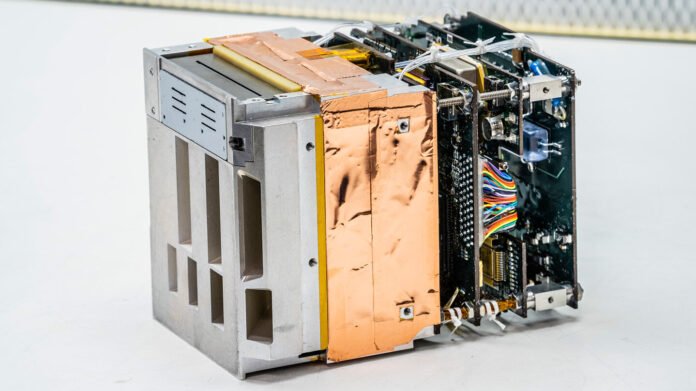
Just a short distance inland from the waves crashing against California’s shore, NASA’s Relativistic Electron Atmospheric Loss (REAL) CubeSat mission launched into the sky, taking off at 2:13 p.m. ET on July 23 from Vandenberg Space Force Base near Santa Barbara aboard a SpaceX Falcon 9 rocket.
Riding alongside other NASA missions, including TRACERS (Tandem Reconnection and Cusp Electrodynamics Reconnaissance Satellites) and the agency’s new wideband communications system PExT, REAL set off with a groundbreaking instrument developed by scientists and engineers at the Johns Hopkins Applied Physics Laboratory (APL) in Laurel, Maryland, to help characterize the forces that cause electrons in Earth’s donut-shaped radiation belts to suddenly drop into the planet’s atmosphere, where they can damage orbiting satellites and have an impact on the atmosphere.
The REAL CubeSat successfully deployed just 54 minutes after launch. In the coming days, the team will establish contact with the spacecraft to ensure its health and operability as it begins its six-month primary mission.
“We have been excited about this launch for years now, and to see REAL off onto its mission is really exciting,” said Robyn Millan, a space physicist at Dartmouth College in New Hampshire and REAL’s principal investigator. “I am proud of this team that worked hard to bring REAL to life. We’re eager to start collecting data and shedding light on the processes influencing Earth’s radiation belts.”
Like magnetic traps, Earth’s radiation belts—also known as the Van Allen Belts, after their discoverer James Van Allen—capture relativistic particles that have been driven to high energies. But occasionally, something shakes them loose so they fall spiraling into Earth’s atmosphere, sometimes in short, 100-millisecond microbursts, other times in waves that can last minutes to hours. Scientists suspect certain types of plasma waves are responsible for the fallouts, and REAL will help find out for sure.
“REAL’s successful launch and entry into orbit are direct results of the hard work, ingenuity and unwavering commitment of a resourceful team to develop a mission that will solve enduring mysteries about Earth’s radiation belts,” said Bobby Braun, head of the Space Exploration Sector at APL.
“In coordination with Dartmouth and Montana State University, APL has again demonstrated the exceptional accomplishments that come through collaborating with other organizations to develop groundbreaking capabilities and technologies.”
Key to achieving the mission’s scientific goal is its novel, miniaturized energetic particle detection instrument, also called REAL, that makes up nearly half of the spacecraft. As the CubeSat flies in low Earth orbit, it will point this particle detector along Earth’s magnetic field to watch as energetic electrons and protons enter the atmosphere.
From there, it can simultaneously measure the quantity, energy and angle of the particles as they fall into the atmosphere—a first-of-its-kind capability—making it possible for scientists to identify the forces that shook those particles free in the first place. This novel capability is already enabling future mission concepts and technologies that will help us better understand and protect our nation’s critical space infrastructure from the hazardous space environment.
“REAL is taking a closer look at the microscopic interactions that have big impacts on the Van Allen Belts,” said APL physicist Thomas Sotirelis, instrument scientist for the REAL particle detector and originator of the instrument concept. “By focusing on those tiny details, we’re going to gain a deeper understanding of Earth’s radiation belts that will help us protect infrastructure now and in the future.”
Provided by
Johns Hopkins University
Citation:
Science in REAL time: CubeSat poised to explore Earth’s radiation belts (2025, July 25)
retrieved 25 July 2025
from https://phys.org/news/2025-07-science-real-cubesat-poised-explore.html
This document is subject to copyright. Apart from any fair dealing for the purpose of private study or research, no
part may be reproduced without the written permission. The content is provided for information purposes only.






